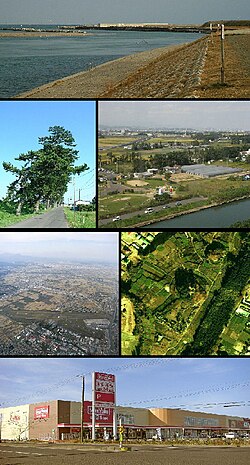Natori, Miyagi
Natori
名取市 | |
|---|---|
City | |
 Natori River, Andon Matsuri Teizan-bori, Sendai Airport Raijinyama kofun, Aeontown Natori Shopping Center | |
 Location of Natori in Miyagi Prefecture | |
| Coordinates: 38°10′17.5″N 140°53′30.5″E / 38.171528°N 140.891806°E | |
| Country | Japan |
| Region | Tōhoku |
| Prefecture | Miyagi |
| Government | |
| • Mayor | Sasaki Isō |
| Area | |
| • Total | 98.17 km2 (37.90 sq mi) |
| Population (October 1, 2018) | |
| • Total | 78,136 |
| • Density | 800/km2 (2,100/sq mi) |
| Time zone | UTC+9 (Japan Standard Time) |
| - Tree | Japanese beech |
| - Flower | Peach |
| Phone number | 022-384-2111 |
| Address | Yanagida 80, Masuda, Natori-shi, Miyagi-ken 981-1292 |
| Website | http://www.city.natori.miyagi.jp/ |

Natori (名取市, Natori-shi) is a city located in Miyagi Prefecture, Japan. As of 1 June 2019[update], the city had an estimated population of 78,676,[1] and a population density of 801 persons per km². The total area of the city is 98.17 square kilometres (37.90 sq mi).
Geography
Natori is in east-central Miyagi Prefecture, bordered by the Pacific Ocean to the east. Natori is located in the fertile plains of the Natori River and the Masuda River deltas; however, the Natori River is actually not inside Natori city limits. Traditionally, the area known as Natori District extended from the Natori River in the north and into the west. However, these regions have been absorbed into the greater Sendai area and are no longer part of Natori.
Neighboring municipalities
Demographics
Per Japanese census data,[2] the population of Natori has increased over the past 40 years.
| Census Year | Population |
|---|---|
| 1970 | 40,845 |
| 1980 | 49,715 |
| 1990 | 53,732 |
| 2000 | 67,216 |
| 2010 | 73,134 |
Climate
Natori has a humid climate (Köppen climate classification Cfa) characterized by mild summers and cold winters. The average annual temperature in Natori is 12.6 °C. The average annual rainfall is 1252 mm with September as the wettest month. The temperatures are highest on average in August, at around 24.9 °C, and lowest in January, at around 1.5 °C.[3]
History
The area of present-day Natori was part of ancient Mutsu Province, and was under control of the Date clan of Sendai Domain during the Edo period, under the Tokugawa shogunate. In 1867, Natori came within the borders of the new Rikuzen Province, which later became part of Miyagi Prefecture. With the establishment of the modern municipalities system on April 1, 1889 Natori District was formed with six villages: Masuda, Higashi-Taga, Shimo-Masuda, Tatekoshi, Aishiwa and Takadate. On April 1, 1896 Masuda was elevated to town status as was Higashi-Taga on April 1, 1928. On April 1, 1955 the towns of Masuda and Yuriage, and the villages of Shimo-Masuda, Tatekoshi, Aishiwa and Takadate were merged to create the town of Natori, which was elevated to city status on October 1, 1958. The official boundaries of Natori City have changed since 1958, as Sendai City redefines its area to include districts to the north and west of Natori.
Damage and casualties from 2011 Tōhoku earthquake and tsunami
The area was badly affected by the 2011 Tōhoku earthquake and tsunami.[4]
Large portions of the coastal area including the Sendai Airport was severely damaged by the tsunami.[5]
On March 14 Rescue workers arrived in an area of Natori known as Yuriage found few survivors, as much of the Yuriage area was wiped out. The population had 30 minutes between the earthquake and the tsunami and though many had time to escape city officials say it is impossible as yet to determine the number of casualties.[6]
Government
Natori has a mayor-council form of government with a directly elected mayor and a unicameral city legislature of 21 members.
Economy
Natori has a mixed economy. Based on data collected in 2000:
- 6.4% of the population of Natori is involved in the primary agricultural and fishing industries.
- 26.1% of the population of Natori is involved in secondary processing industries, particularly at the Nikon Camera factory and at the Sapporo Breweries factory.
Public facilities
Medical facilities
Natori is home to the Miyagi Prefectural Psychiatric Medical Center and the Prefectural Cancer Center.
Educational and cultural facilities
Natori's educational facilities include a private university (Shokei Gakuin University).
The city has eleven public elementary schools and five public junior high schools operated by the city government and two public high schools operated by the Miyagi Prefectural Board of Education. The prefectural also operates one special education school and two technical schools.
The Natori City Library has a collection of approximately 140,000 books (two books for every person in the city) as of 2002.
The Cultural Meeting Center (文化会館, Bunkakaikan) has a medium-sized hall and rehearsal room, a music room, a cultural centre which includes an exhibition gallery, a professional concert hall and stage, catering facilities and meeting rooms, and other general-purpose facilities for communal use. The structure was designed by Fumihiko Maki and is considered a local attraction.
Additionally, Natori is home to a Media Resource Centre, a community gym, the Miyagi Cycling Centre, and several public beaches and swimming pools.
Transportation
Airport
Railway
- East Japan Railway Company (JR East) – Tōhoku Main Line / Jōban Line
- East Japan Railway Company (JR East) – Sendai Airport Line
Highway
- Tōhoku Expressway: Minami-Sendai IC
- South Sendai Expressway: Yamada IC
- East Sendai Expressway: Natori and Sendai Airport IC
- National Route 4
- National Route 286
Local attractions
Festivals
The Natori Summer Festival is held in early August, and is a town celebration of summer. The celebration is marked by fireworks and traditional Japanese festival foods, such as yakisoba and yakiniku.
The Sapporo Beer Festival is held at the Sapporo Beer Factory. The factory opens to the public for tours of the factory and other events including free beer tasting.
The Donto-sai Festival is held at the height of winter. Men and women wear only sparse, white clothing and walk silently through the town, receiving sake from local residents along the way. The event culminates in a communal purification ritual and bonfire at Takekoma Shrine.
Sports
The Natori Sports Park, constructed by Tohoku Electric, is a public area used for various sports meetings and other community events, such as open-air markets.

Historical sites
The Nakazawa Family Estate (住宅, Juutaku), ancestral home of the Nakazawa Clan of bushi warriors, has been designated a National Treasure under the Law for the Protection of Cultural Properties. It was constructed in the late 18th century and has an historically important design, including a thatched roof.[7]
There is a park in Natori dedicated to the Mountain Tomb (山古墳, yamakofun) of the Thunder God (雷神, Raijin). This is a keyhole tumulus constructed sometime circa the 4th and 5th centuries CE. The park contains numerous other tumuli of varying age, both keyhole and circular.
Natori is home to several sites and artifacts related to Date Masamune, the founder of Sendai Domain. These include 300-year-old pine trees standing by the Natori River dike, which are decorated with paper lanterns and are said to have been planted by Masamune himself.
Other sites
Natori, as a coastal town, has open local fresh fish markets. These markets are open in the port district, every Sunday throughout most of the year.
Specialty products, items and gifts
Because of the Japanese tradition of gift-giving, most cities in Japan have something considered a "local specialty" to be used as omiyage. Natori's main omiyage specialty is kamaboko, a fish paste boiled in bamboo grass. Another local specialty is "beer-tella", a form of castella sponge cake that has been made with brewer's yeast rather than baker's yeast. As one might expect, "beer-tella" smells strongly of beer, and is made at the Sapporo Beer Factory.
Sister city relations
 – Guararapes, Brazil,[8] since March 31, 1979
– Guararapes, Brazil,[8] since March 31, 1979 – Kaminoyama, Yamagata, Japan since May 10, 1978
– Kaminoyama, Yamagata, Japan since May 10, 1978 – Shingū, Wakayama, Japan since October 8, 2008
– Shingū, Wakayama, Japan since October 8, 2008
References
- ^ Natori city official statistics (in Japanese)
- ^ Natori population statistics
- ^ Natori climate data
- ^ McLean, Alan; Quealy, Kevin; Ericson, Matthew (March 13, 2011). "Satellite Photos of Japan, Before and After the Quake and Tsunami". The New York Times.
- ^ "News: Tsunami rolls through Pacific, Sendai Airport under water, Tokyo Narita closed, Pacific region airports endangered". Avherald.com. 2001-07-06. Retrieved 2011-03-11.
- ^ "Rescuers, but no one left to rescue in Natori". NBC News World Blog. 16 March 2011. Archived from the original on 16 March 2011. Retrieved 16 March 2011.
- ^ 名取市- 名取市ガイド「重要文化財旧中沢家住宅,藤原実方朝臣の墓」
- ^ "International Exchange". List of Affiliation Partners within Prefectures. Council of Local Authorities for International Relations (CLAIR). Archived from the original on 22 December 2015. Retrieved 21 November 2015.
External links
![]() Media related to Natori, Miyagi at Wikimedia Commons
Media related to Natori, Miyagi at Wikimedia Commons
- Official website (in Japanese)



